
We have all the different shapes and sizes of motorhomes arrive here at Horton Common each year from the tiniest camper vans to very larger A-Class motorhomes. For this post, I thought I would summarise the different classes and types of motorhomes available in the UK. Also, what are the pros and cons of different shapes and sizes of motorhomes? This post is partly based on my own opinions of seeing a wide variety of motorhomes each year but also from the feedback of our guests on their experiences.
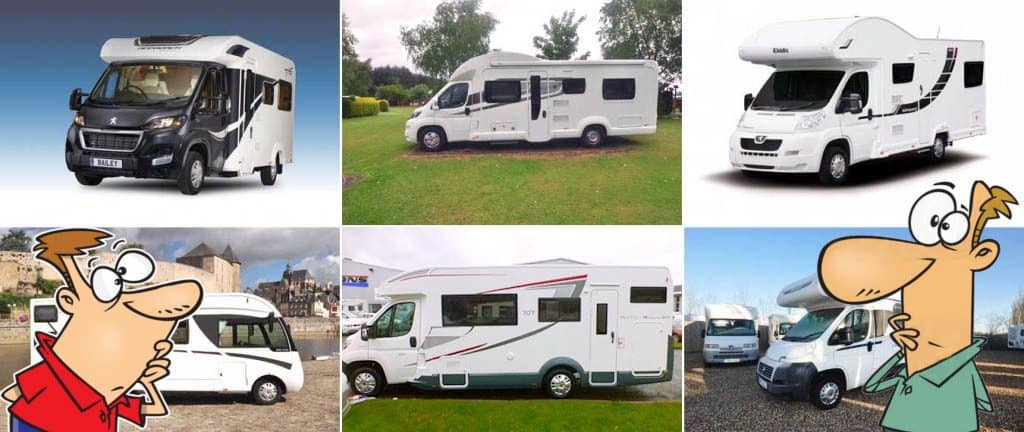
The content of this post is primarily targeted at motorhome beginners.
However, if you are looking to change your motorhome for any reason, the information below may help you choose the body type/class of motorhome which will suit your needs the best.
You may also be interested in my article on the best cheap/budget motorhomes where I provide the cheapest examples I’m currently aware of each type of motorhome shown below.
This post is quite long as it discusses the different pros and cons of each motorhome class.
However, if you are looking for just a short and sweet description of the different motorhome body types found on UK roads, the quick (2 minutes) video below from Caravan Guard Insurance should do the trick:
Disclaimer: Hey! By the way… any links on this page that lead to products on Amazon or Caravan Guard are affiliate links, and I earn a commission if you make a purchase, with no additional cost to you 🙂
- Dissolves waste and removes odours naturally and has delightful mild fragrance
Want To Visit Horton Common? – Book Here
Table of Contents
Campervans – Are They Really A Motorhome?
Now, many people don’t specifically regard campervans as motorhomes per se. But I’ll get into that in another post.
The smallest camper vans are typically based on people carriers, also referred to as MPVs (Multi Purpose Vehicles).
For instance, one of the smallest campervans currently available in the UK is based on the Nissan NV200, as seen in the video below:
You then obviously have larger campervans. One of the most popular of which I’m sure you are aware of are/were produced by VW.
Going all the way back to the classic VW camper vans of the 1960s to the current generation, VW camper vans are the most common/popular option you’ll come across.
The benefits of such vehicles are they can have genuine day-to-day practical use. They are not just for going on your holidays. The downsides, well, they are obviously very small.
You have no toilet/shower facilities, and often, they can get pretty cold. Hence, generally, only recommended for summer use. More on this topic in my post on campervans vs motorhomes.
Panel Van Conversion Motorhomes
Now, some people still regard panel van conversions on the edge of the definition of a ‘proper motorhome’. It comes down to the use of the word ‘home’.
In other words, does a panel van conversion provide you with sufficient facilities to provide a ‘homely’ experience?
Well, that’s obviously subjective, and it also depends on the specific panel van conversion in question.
For a general description let’s just say that you will often find more space and facilities in a panel van conversion over a campervan.
In terms of what a panel van conversion motorhome actually is, the clue is in the name. These vehicles will either start as a new commercial vehicle or a used van.
I do have guests who have gone the DIY route. They purchased a used commercial van and carried out their own panel van conversion.
The results are often very impressive. Not only do they end up with a living space exactly to their preferences and requirements they also save a pretty penny in doing so.
I do want to write some posts in the future on DIY panel van conversions.
There is a huge range of different panel van motorhomes on the market based on Fiat, Peugeot, Citron, Ford and Mercedes commercial vehicles.
A panel van conversion which I think personally offers a good balance of space, features and affordability especially if you are considering a used motorhome is a Lunar Landstar based on the Mercedes commercial vans.
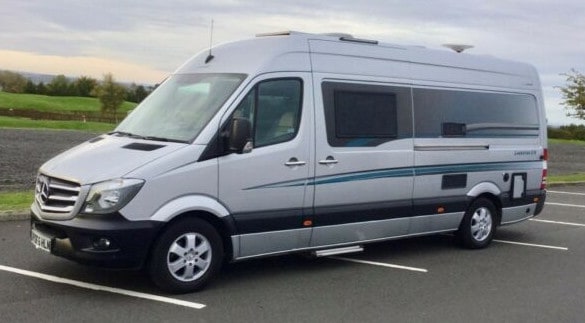
So I’ve briefly discussed what a panel van conversion motorhome is.
Let’s now start to discuss some of the advantages and disadvantages compared to campervans and other options discussed below such as coachbuilt and A-Class motorhomes.
Advantages of Panel Van Motorhomes
While a panel van conversion motorhome is obviously larger than a car or motorhome its generally not too daunting to get to grips with driving one.
Furthermore, pretty much all panel van motorhomes have a total rated weight of under 3,500kg. Therefore, if you only have a B-class licence such as myself, you are ok to drive one legally.
That’s potentially not the case with some of the larger coach-built and A-Class motorhomes discussed below.
Vehicle Width & Parking
As the width of the vehicle is the same as a standard delivery van, you should be able to fit down pretty much any UK street.
Furthermore, the height of a panel van conversion motorhome often means you can take it to car parks that larger coach-built or A-Class motorhomes simply can’t go.
Therefore, that’s where the real benefit of a panel van conversion motorhome comes in. Even simple things like going to the supermarket. In a panel van conversion, that’s a pretty easy trip.
Its not so simple with some coach-built motorhomes, and its especially not the case with many A-Class motorhomes.
What this obviously means is with a panel van motorhome, you don’t need to consider towing a car for mobility when out and about.
We have several guests each year that tow a car behind their large coachbuilt or A-Class motorhome to get around in.
There are obviously those who question if someone is comfortable towing a car behind a motorhome why not just have a car and caravan? Its a reasonable question to ask, and I’ll discuss that in a later post.
Disadvantages Of Panel Van Motorhomes
The most obvious restriction is space. As the sides of a panel van motorhome remain the same as the base commercial vehicle, you don’t have the internal width of a typical coachbuilt motorhome.
This obviously, therefore, limits internal layout options and facilities.
In terms of internal head height, again, a panel van conversion will typically have less than a coachbuilt or A-Class motorhome.
Some panel van conversions are referred to as ‘high tops’ which provide additional head height.
However, that then can limit the previous advantage of a panel van conversion with regard to accessibility.
For instance, a high-top panel van conversion may not be able to get under a car park height restriction barrier.
Washroom & Wetroom Facilities
If you don’t intend to use the onboard facilities in your motorhome, this is not a downside at all.
However, if you are visiting a site such as ours that cannot provide a separate toilet/shower block this can be a potential downside.
Due to the width/height/length restrictions on motorhome panel van conversions, in some cases, no dedicated toilet/shower space is provided at all.
In that case, I personally refer to them as just a camper van and not a motorhome.
In many cases, if one is provided, it will be a small ‘wet bath’ where the toilet and shower space are as one. Hence, you cannot have a shower without getting the whole area (toilet/sink) wet.
I previously referenced the Lunar Landstar as one of my favourite panel van conversions. One of the reasons that’s the case is it has sufficient internal space to have a separate toilet and a shower.
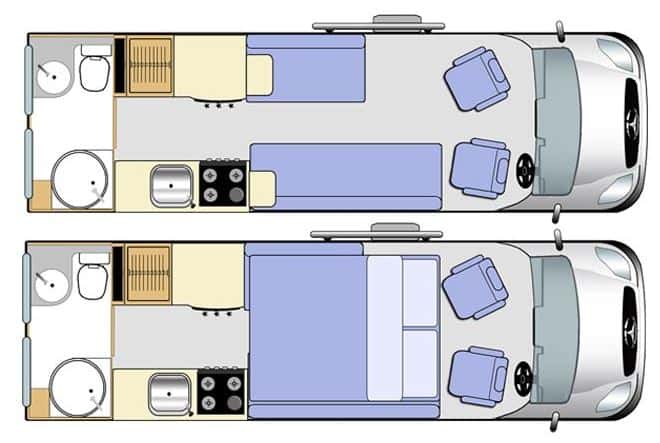
Coachbuilt Motorhomes
A coachbuilt motorhome starts off life a bit differently than a panel conversion. I recently wrote a post on how is a motorhome built.
Essentially two cabs are joined together and sent to AL-KO. They then produce a lightweight chassis to suit the coachbuilder’s requirements.
The coachbuilder will then use a variety of materials including fibreglass, aluminium and wood, to create a body for the motorhome, which joins up to the cab.
Coachbuilt motorhomes can actually weigh less than panel van conversations for an equivalent size, due to the lightweight chassis.
However, that lightweight chassis may result in a lower user payload and be less suitable for a tow-behind car in some cases.
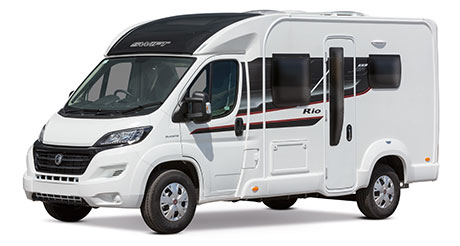
Low Profile VS Overcab Bed Coachbuilt Motorhomes
The image above shows what’s described as a low-profile coachbuilt motorhome.
This description refers to the lack of a body projection over the cab at the front of the motorhome found on an overcab motorhome seen in the image below.
Essentially, the overcab can be a sleeping space, or it can provide additional storage. These can obviously be important benefits to achieve a four-berth or six-berth motorhome.
However, there are potential downsides with overcab coachbuilt motorhomes.
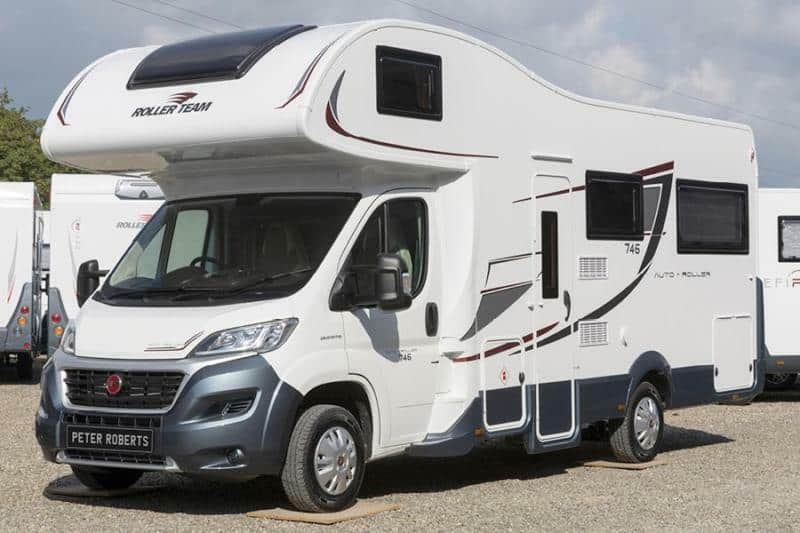
An overcab makes the motorhome less aerodynamic, with the body projection acting as a sail. Now, while travelling on the road at low speed, you probably wouldn’t notice a difference in MPG.
However, when travelling on the motorhome, our guests who have owned both low profile and overcab motorhomes have stated they do notice a difference in MPG.
They have also informed me that reduced stability and road handling can be a concern.
Overcab motorhomes are more prone to being affected by crosswinds. Furthermore, the centre of gravity of the vehicle is slightly higher, potentially making them feel less stable.
Advantages Of Coachbuilt Motorhomes
So as you can see from my comments above, there are advantages and disadvantages between either low profile or overcab motorhomes.
However, here I’ll discuss more general advantages over coachbuilt motorhomes with an original cab.
As previously discussed, compared to panel van conversions, you have a bit more interior space with two vehicles of comparable size.
You also do not have a side sliding door and two rear doors to design the layout around. A coachbuilder is completely free to design different layouts.
Something else worth noting as an advantage over larger A-Class motorhomes is the cab itself. Say you have an accident, and the front of the motorhome (bumper, lights, bonnet) is damaged.
With this type of coachbuilt motorhome, these are still the standard parts fitted to all vans.
Hence, the parts costs are going to be more reasonable than the custom parts made for the front of A-Class motorhomes.
Disadvantages Of Coachbuilt Motorhomes
As previously referenced above, when compared to panel van conversions getting down narrow streets and into car parking areas may be more difficult.
Furthermore, with a lightweight AL-KO chassis, you may have a low user payload and not be able to tow another vehicle.
However, there are coachbuilt motorhomes based on commercial Iveco vans that have larger user payloads and can tow more than a tonne.
When compared to an A-Class motorhome a downside to these coachbuilt motorhomes is they typically cannot utilize the cab seats into the living area of the motorhome as well.
Generally, they won’t feature rotating cab seats, which means there is a very separate divide between the living area of the motorhome and the cab space.
A-Class Motorhomes
The most premium and desirable option for most people interested in a motorhome is an A-Class.
The difference between an A-Class motorhome and the smaller coachbuilt motorhomes above is the front of the motorhome. Non-A-Class motorhomes have the original cab, windscreen and doors.
Where an A-Class motorhome is coachbuilt front to back, this generally provides a much larger front windscreen for better visibility.
So this is where the UK way of describing motorhomes is not ideal because A-Class motorhomes are also coachbuilt.
In fact, when you think about it, they are more coachbuilt than the smaller motorhomes which use the existing van cab.
That’s why the American motorhome categories discussed below are actually better, with A, B and C motorhome classes.
The video below from Motorhome Monthly Magazine shows the three main layout differences you will find with A-Class motorhomes.
Advantages of A-Class Motorhomes
What the fully coachbuilt approach provides for A-Class motorhomes is a better utilization of interior space.
Hence, comparing an A-Class motorhome with a semi-coachbuilt motorhome of the same length, you will have more usable space inside the A-Class.
As the video shows above, the large drop-down double bed over the cab found in many A-Class motorhomes is one of its best features.
Its easier to get access to than semi-coachbuilt motorhomes with overcab beds. Furthermore, it doesn’t feature the overcab projection, which can present issues as described above.
A-Class motorhomes don’t usually require the use of thermal blinds. This is due to several reasons, including the shallow angle of the windscreen.
Large Rear Garages
Something I have noted from our guests with A-Class motorhomes is that you will also typically get some of the largest rear garages.
Within these garages, you can store bikes, camping chairs and other possessions.
They can provide a real benefit to the practicality of the motorhome, and it avoids hanging bikes on the back.
However, you do have to be careful not to put too much weight in the rear garage paying attention to your payload limits.
Placing too much weight in the back could also impact handling/steering characteristics.
Disadvantages Of A-Class Motorhomes
The first problem for many is the cost. A-Class motorhomes, as they are fully coachbuilt, are the most expensive option available. They are also typically the most expensive to insure and run.
However, the running costs may actually be less than an overcab bed semi-coach built. More on that below.
Typically A-Class motorhomes are also the tallest option, so again limited access to certain places has to be acknowledged.
In terms of weight, several of the larger A-Class motorhomes are over 3,500kg.
So to legally drive one, you will need to have passed your test before 1997 or be in possession of a B+E licence. However, there are some A-Class motorhomes rated at 3,500kg.
MPG & Motorhome Running Costs
Many panel vans, coach-built, and A-Class motorhomes use similar diesel engines. Therefore, the starting point for the cost of running the motorhome on fuel is pretty similar.
However, aerodynamics plays a big part in how much your motorhome costs to run per mile, especially when travelling at speed on the motorway.
You will typically find a panel van conversion motorhome has better aerodynamics than many coachbuilt motorhomes, especially those with overcab beds.
However, with panel van motorhomes based on a heavy commercial chassis and many coachbuilt motorhomes based on lightweight AL-KO chassis, that is another factor to consider.
With A-Class motorhomes generally being the biggest and heaviest, they will return the lowest MPG figures.
However, I did have a guest who upgraded from a coachbuilt motorhome with an overcab bed to an A-Class motorhome.
While the A-Class was heavier, it did have better aerodynamics and returned a higher MPG, not by much, but it wasn’t any worse.
You could consider a motorhome engine remap, which I’ve discussed in a previous post may help with MPG. However, there are risks with remapping along with the rewards.
What’s The Difference Between UK & US Motorhome Classes?
When searching for information online about the different motorhome classes and types, you will come across different information if it comes from a US or UK-based website.
For instance, in the UK, we do have A-Class motorhomes. However, that’s the only type of motorhome we refer to by a specific class.
However, in the US, they describe their motorhomes/recreational vehicles (RVs) under a wider class-based category system.
US Class B Motorhomes Are Similar To UK Panel Van Conversions
In the US, these types of motorhomes are described as camping vans, conversions vans or touring vans.
Obviously very similar in appearance and capability to UK panel van conversions. However, there are a few differences.
In the US, its more common for Class B motorhomes to always have a combined toilet and shower (wet bath). The reason is, wild camping is more common in the US than in the UK.
While some UK panel van motorhome owners do wild camp. Its more common for them to visit a campsite with full facilities.
Also, UK panel van conversions are generally based on smaller base vehicles. Hence, there is simply less available space to fit a wet bath.
However, there are UK panel van conversions based on Mercedes vans which do offer them.
US C-Class Motorhomes Are Similar To UK Coachbuilt Vans
With US C-Class motorhomes, while they are similar to the UK coachbuilt motorhomes, again, there are some differences.
For instance, in the US their choice/range of van chassis to base a Class C motorhome on is much more varied than in the UK.
The chassis is typically more heavy-duty, so can carry more weight. Therefore, on average, a typical American Class C motorhome is much larger with a much higher payload than your typical UK coachbuilt motorhome.
Also, in the US, they have a range of large pick trucks (much more capable than UK pickups), which Class C motorhomes can be based on.
US A-Class VS UK A-Class Motorhomes
With regards to A-Class motorhomes, the definitions between the two countries is very similar.
However, as I’m sure you’re probably not surprised with the fact that a US A-Class motorhome is significantly larger than a UK A-Class motorhome.
In the UK, a typical A-Class motorhome is based on the same Fiat, Ford, Mercedes or Iveco chasses as many cab/coachbuilt motorhomes.
However, in the US, an A-Class motorhome is based around what we would refer to in the UK as a large bus/coach or lorry.
In the UK, a typical A-Class motorhome will weigh between 3.5 and 7 tonnes. In the US, a typical A-Class motorhome is between 6 and 14 tonnes. Some are even heavier.
Conclusions On Motorhome Classes & Types
So hopefully, the above information has clarified any confusion you may have had between the different motorhome classes.
In terms of which motorhome type is best for you, well, that depends on lots of factors.
Obviously, your budget and berth number you require, but also how flexible you need to be in terms of where you want to take your motorhome.
If you want to explore the more niche/narrow roads and destinations, a panel van conversion/semi-coach built motorhome may be more suitable.
However, if you’re looking for the most space and features and the price is not a problem, then an A-Class is worth considering.
If you are considering a used motorhome I would encourage you to read my post on private motorhome sales.
Anyway, thanks for reading, and I hope, at some point in the near future, you will consider coming to visit us here at Horton Common.
Our road and hardstanding fully serviced pitches are ideal for all motorhomes, big and small. 🙂
Want To Visit Horton Common? – Book Here

